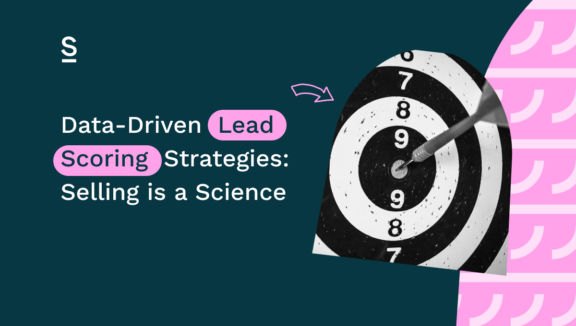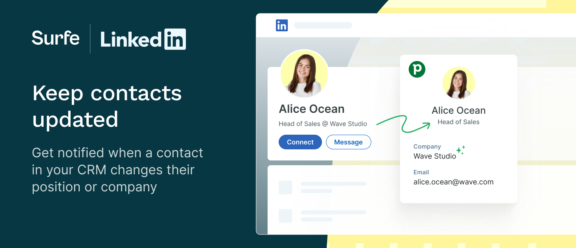Data-Driven Lead Scoring Strategies: B2B Selling is a Science

Sales teams want (need) leads. But even when they have them, drowning in a sea of leads comes with its own problems (We call it a ‘rich-person’s problem’ at Surfe but it can be a problem nonetheless).
Even when the leads are flowing in, it can be a struggle to identify the most promising prospects amidst the noise. After all, you want to spend your time and resources on the leads that are going to return the highest value, right? You want to focus on leads that are going to spend more money on your product or service, are likely to bite the bullet quicker, least likely to churn, and maybe even refer a few more high-quality leads too. But how do you identify those leads?
Data-driven lead scoring is the answer. Having the right mixture of human-touches and automation in a strategy that is driven by data, sales teams can prioritize high-potential leads, spend time and resources on leads most likely to convert, and achieve higher conversion rates.
This is a science that we’re going to dive into together and at the end of this article you’ll fully understand how to implement a data-driven lead scoring strategy that allows you to focus on the most valuable leads.
In this article, we’ll cover:
What is Lead Scoring?
Lead scoring systematically and automatically ranks your leads based on their likelihood to convert so that you know which leads to focus your time and resources on.
Previously, salespeople might rely on intuition or basic information like job title to judge a lead’s value. Today, with the explosion of data available, companies can leverage a much richer set of signals. This allows for data-driven lead scoring, which creates more accurate and objective lead assessments.
For instance, in a recent study published in the Information Technology and Management Journal, effective lead scoring models deliver as much as a 50% increase in annual revenue.
A lead scoring process awards points to your leads based on conditions or criteria. So a lead can earn points based on their industry, company size, job title, etc. but they can also earn points because of actions they’ve taken such as visiting your pricing page or clicking a link in a marketing email. These points add up, and when they reach a certain score (called a threshold), you know they’re ready to buy and can adapt your sales strategy to start pushing them towards a demo call or conversion campaigns. The conditions and criteria that awards points vary from company to company, meaning they’re awarded points specifically because of positive buying signals for your business.

Data Points for Effective Lead Scoring
The key to a successful lead scoring model is gathering the right data points. These points paint a picture of your lead, helping you identify those most likely to convert into paying customers. Here’s a breakdown of the different types of data to consider:
Explicit Data
This is the basic who, what, and where the information you collect from leads, typically through forms or by scraping LinkedIn or other third-party databases. Think about company size, industry, and location. A 2023 LeadGenius study shows that 73% of B2B buyers expect companies to personalize their sales outreach based on firmographic data. By understanding a lead’s company background, you can assess their potential fit for your product or service.
Implicit Data
Not all leads explicitly tell you they’re interested. Website behavior offers valuable clues. How long do they stay on your site? What content do they download? Implicit data suggests a lead’s level of engagement and purchase intent.
Behavioral Signals
Take email interactions a step further. Do leads open your emails? Click on links? Submitting forms is a strong indicator of interest. Tracking these behavioral signals helps prioritize leads who are actively considering your offering.
Social Media Activity
Social media listening provides another data point. Are leads mentioning your brand or engaging with relevant industry topics? This can reveal their interests and buying stage, allowing you to tailor your outreach accordingly, including when is the best time to post on social media.

Building a Lead Scoring Model
Now you know what a lead scoring process is and the types of data powering it, it’s time to understand exactly how to implement one. These processes don’t appear by magic – you’ll need to dedicate some time to setting the process up – but once your process is in place, the ROI is clear.
1. Know Your Ideal Customer Profile (ICP) Inside Out
Before building your process, you need a clear picture of who your target leads are—your ideal customer profiles. Define the characteristics of your most successful clients. This could include company size, industry, budget, as a basic, but it’s important to also identify any specific needs or challenges they face.
We mentioned before how lead scoring conditions and criteria vary from company to company. Identifying your ICP is how you’re going to decide what conditions and criteria award points to a lead. If you identify that your ICP is a company in a specific geographical location with a company size above a certain point, you’re going to award leads points based on that.
2. Selecting the conditions and criteria that award points
Not all data points are created equal. Now that you know your ideal customer profile, choose data points that align with those characteristics and the different stages of your sales funnel.
These data points can come from various sources, like website visits (implicit data), downloaded whitepapers (explicit data), or even social media activity (behavioral signals). Pick data points that indicate someone’s interest level and progress through your sales process.
3. Choosing the tool for your lead-scoring process
It’s important that you’re using the right tool to award points to leads automatically. That way, you can check at any time where a specific lead sits in the process and your outreach can be sent automatically based on the points they’ve earned. Your most likely choice is your CRM. All of your leads are already in your CRM, it’s the best place for collecting and tracking data related to your leads, and you can also often send outreach from there too. This way, your contact data, lead scoring, and outreach are all working together from the same place.
4. Assign point values based on importance
Depending on your business model, the lead’s geographical location may be more important than their company size. Or perhaps the number of sales reps they have is more important than the industry they’re working in. So you’re going to allocate more points for more important factors.
This is also relevant for the lead’s actions. For example, a whitepaper download on a product comparison might be worth more points than simply visiting your homepage.
5. Setting your lead score threshold: who makes the cut?
Now that you have a systematically ranked list of leads, you can determine who to start pushing towards conversion (hot leads) and who needs more nurturing (cold leads).
Leads exceeding a specific score might be classified as “hot” and prioritized for sales outreach, while those with lower scores might be nurtured with additional marketing content before sales engagement.
The score you choose as a threshold will vary based on the resources you have available to handle them and the number of leads that meet the threshold. For example, if you set your lead scoring threshold too high, you might not have many leads that meet it. To the contrary, if your threshold is too low, you might end up flooding your sales team with leads again, which means it’s time to increase the threshold.
The good thing is that you can adapt your threshold as necessary and increase or decrease it at any time.
6. Gathering the best data for your lead scoring process
To implement an effective lead scoring strategy, it’s essential to gather accurate and comprehensive data about your leads. for example, if you’re awarding points based on company size, how do you actually know their company size? How do you get that data into your CRM automatically so the points can be awarded? Surfe simplifies this process by taking data from the LinkedIn profiles of your leads in automatically migrating it to your CRM.
By using Surfe, you can effortlessly transfer valuable data from LinkedIn profiles—such as names, job titles, company information, and professional email addresses—directly into your CRM. This is the type of data that provides a robust foundation for your lead scoring process so that you can allocate points based on relevant criteria. Whether it’s demographic details or behavioral signals, the data captured by Surfe ensures your lead scoring model is driven by precise and up-to-date information, enhancing the accuracy and effectiveness of your sales efforts.
7. Continuous Coaching: Monitor and Refine
Continuous feedback and coaching are fundamental. Like any winning team, your lead scoring model needs constant monitoring and adjustments. Regularly review your model’s performance based on feedback from your sales team and key sales efficiency metrics like conversion rates.
Are the “hot” leads actually converting? Are you missing out on valuable leads with low scores? Is there another condition or criteria you’ve missed that needs adding to the lead scoring criteria? Based on this feedback, refine your point values, data points, and thresholds to ensure your model continues to identify the most promising prospects for your sales team.

What sets the best lead-scoring systems apart?
Basic lead scoring is a powerful tool, but going that few steps further can ensure that the leads meeting your threshold are just waiting for you to conver them. The best lead-scoring systems make conversion seem to happen by itself and your sales team will love you. Here’s how:
Negative scoring
Not all leads are created equal. Negative scoring allows you to identify and remove leads from your nurturing sequence who show signs of low interest, like repeatedly unsubscribing from emails. For example, you may have awarded points to a lead because they submitted a form. But what if in that form they signaled that they’re only interested in purchasing 2 licenses and you want your sales team to focus on leads of 10 licenses and above? You can remove points based on this to ensure that you’re not pushing leads to the sales team that end up being low-value.
Lead nurturing automation
By connecting your lead score to your marketing automation platform and sales outreach, leads automatically receive personalized emails, downloads, and other content relevant to their interests and stage in the buying process. It’s not always as simple as ‘cold leads’ and ‘hot leads’. Imagine a lead has been sitting in your lead scoring process for a couple of months but haven’t yet reached the threshold. It’s likely they need an extra push and different messaging in the outreach they receive compared to a fresh lead that has just entered the process and only just heard about you.
Predictive lead scoring
The best lead-scoring processes take their lead scoring one step further with the power of machine learning. Predictive scoring analyzes historical data and behavioral patterns to estimate the likelihood of a lead converting into a customer. This allows you to prioritize your outreach even before a lead meets a threshold – you’ll decrease the length of the sales cycle and be able to push leads towards the threshold quicker.
Integration with marketing automation
A siloed sales and marketing team can hinder your lead nurturing efforts. Information flows seamlessly between departments by integrating your lead scoring system with marketing automation tools. This ensures targeted messaging and a smooth handoff from marketing-qualified leads to the sales team.
Let’s Wrap It Up!
As we wrap up, it’s clear that selling is indeed a science—one that requires precise targeting and effective prioritization of leads (but luckily doesn’t require 5 years of university to be qualified – pardon the pun). By leveraging data, sales teams can systematically identify and focus on high-potential leads, ensuring that their efforts are directed where they will yield the greatest returns.
Having all your data and lead scoring process managed in your CRM allows every gear in the machine to be working together. Implementing tools like Surfe, which seamlessly integrates LinkedIn with your CRM, ensures that the data feeding your lead-scoring process is accurate and updated in real-time.
There’s not much left to do except get started on your own lead-scoring process. We’d recommend taking your time when implementing it – don’t rush through it and don’t worry about spending too much time on it – the outcome will be an automated list of leads that are ready to purchase and it’s going to have an ROI that is worth every second spent on it.
Get started now and begin feeding your lead scoring process with data gathered by Surfe – it’s free for 2 weeks, there’s no setup or credit card required, and ensures that the data feeding your lead-scoring process is as accurate as possible and always up to date.

Drive your lead scoring with real-time contact data
Surfe takes data directly from the LinkedIn profiles of your leads and feeds it into your CRM automatically meaning your CRM is always up-to-date with accurate data.


